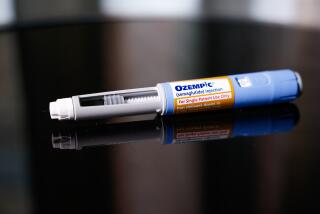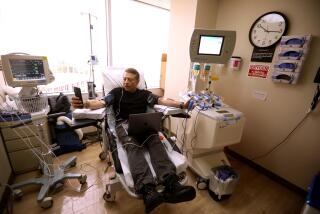Medicare Warily Eyes Treatment for Macular Degeneration
- Share via
Two-thirds of all Americans have never heard of macular degeneration, the leading cause of blindness in Americans over age 65. As we live longer, however, chances are that some of us will learn firsthand about this incurable eye disease that robs people of their central vision.
So when a new experimental treatment came along that promised to stop vision loss, it was no surprise that many doctors and patient advocates began to clamor that the therapy be covered by health insurance programs. After all, the eye disease affects nearly 2 million adults over age 65.
The treatment, called ocular photodynamic therapy, is used to treat patients with the “wet,” or more serious form, of macular degeneration. Blood vessels in the eye grow abnormally, leaking fluid, then forming lesions that result in sudden and severe loss of sight. Each year about 200,000 people are diagnosed with wet macular degeneration. Some lesions are easy to detect.
Those are the “classic” kind. The occult variety are less defined and harder to spot.
With photodynamic therapy, a doctor injects a patient with the drug verteporfin, or Visudyne. A laser activates the drug, which temporarily seals the leaking blood vessels. The blood vessels eventually reopen after several months, however, and several treatments are needed. Dr. Kirk Packo, a Chicago ophthalmologist, says most patients require five treatments over two years, each costing $2,200--or a total of about $11,000. Follow-up care is also necessary, which adds another $3,000 or so to the cost.
The treatment is not a cure for macular degeneration but some scientists contend that it can significantly benefit patients by delaying the onset of blindness. And the Food and Drug Administration has approved verteporfin for treating the disease. Sound like a slam-dunk case for coverage by health insurers? Not exactly. Things in science--or in government rule-making--are never that easy.
The photodynamic therapy is prompting a dispute between government scientists and patient advocates over just how effective the treatment really is and whether the federal Medicare program should pay for it. The outcome of the debate is important to patients with macular degeneration and their families because medical treatments approved for Medicare often are later covered by private health insurers.
That’s why experts say it’s crucial that strong scientific evidence supports expensive new technology. But as so often happens, politics cloud the picture with doctors, patient advocates and the medical industry lobbying for coverage of every new procedure that comes along.
Soon after the FDA approved verteporfin, the Centers for Medicare and Medicaid Services, the federal agency that runs the Medicare program, said it would cover the treatment and drug for patients with classic lesions. Six months later, the Vitreous Society, an organization representing retinal disease specialists, asked the centers to cover treatment for occult lesions.
Last fall, the centers agreed to pay for the treatment, saying in a press release that the expansion of coverage could affect as many as 70,000 new patients
A few weeks later, federal officials had a change of heart after hearing complaints about the validity of a research study that had been instrumental in the original decision. The clinical study that the centers relied on contained “some significant methodological flaws,” says Dr. Sean Tunis, director of Medicare’s coverage and analysis group.
Tunis says the study by researchers at several universities, including Johns Hopkins medical school in Baltimore, and published last year in the American Journal of Ophthalmology, failed to demonstrate its main objective: that the drug-laser therapy helped to arrest the downward course of the disease in patients after a year of therapy. The study did find, however, that, after two years of treatment, patients who underwent the therapy had less vision loss than those who did not.
But Tunis says it was not clear if the two-year result was an actual benefit of the treatment or a statistical anomaly. Moreover, he noted that 5% of patients in the study had a sudden loss of vision after undergoing the treatment, compared to no sudden vision loss in study participants who did not have the therapy.
But several advocacy groups, including the Vitreous Society, the Alliance for Aging Research, the American Macular Degeneration Foundation and the American Council for the Blind, are determined to get the federal agency to reverse its decision again.
They’ve hired a Washington, D.C., public relations firm to help them. They contend that the treatment benefits patients by slowing the advance of the disease, and thus the disability and loss of personal independence that comes from blindness. They also argue that if Medicare doesn’t pay for treatment, only the rich will be able to afford it.
“We’ve said this is not a magic bullet but so what?” says Charles Crawford, executive director of the American Council for the Blind. If the procedure can enable someone to live a more normal life for two to five years, he says, “isn’t it worth it?” Officials at the centers say the agency does not consider cost when deciding which medical treatments the Medicare program should cover. Several years ago, when Medicare officials tried to weigh cost along with scientific evidence, patient advocacy groups protested, saying treatments--typically ones that served their particular interests--should be covered without regard to cost.
Often, these groups get financial support from drug companies or medical device firms, which may mount their own publicity campaigns to generate demand for their products in hopes of eventually getting private or government insurers to cover their treatments.
Novartis Opthalmics, the maker of Visudyne, is encouraging older adults to have eye exams and to receive therapy, if appropriate.
Its campaign includes magazine advertisements, a media tour by actress Lauren Bacall and an Internet site that asks people to sign up for more information about Visudyne.
“The campaign is not really about a drug,” says Shelly Spoeth, of the Atlanta office of Ketchum, a large public relations firm that is handling the Novartis account. “It’s a nonbranded awareness campaign.”
Visudyne is the only drug available for use with ocular photodynamic therapy, and the market potential is huge as millions of baby boomers are set to hit age 50 and beyond. The controversy over whether the government should pay for photodynamic therapy is just the beginning of many debates that will take place as new medical treatments and technologies hit the market in coming years.
How do we make sure people can get the medical treatments that really work--and not just the ones that have the most special interests aligned behind them? With medical insurance premiums rising quickly, and the cost of health insurance unaffordable for many, it is important that we find a better way to sift out new treatments that are wasteful, inappropriate and, in some cases perhaps, just not worth the cost.
*
Trudy Lieberman can be reached by e-mail at trudyal530@aol.com. Health Matters appears on the third Monday of the month.






